Experiment on the Tensile Strength of Concrete Joint Surface at Early Ages
Abstract
Featured Application
Abstract
1. Introduction
2. Materials and Methods
2.1. Preparation of Concrete Specimens
2.2. Concrete Mix Ratio
2.3. Preparation Process
- (1)
- Weighing Materials: According to the proportions listed in Table 1, accurately measure and prepare sufficient quantities of each component raw material. Subsequently, sequentially add these raw materials into the mixer as per the specified order. Throughout the process, strict measures must be taken to prevent any foreign impurities from contaminating the mixture, ensuring the purity of the concrete mix, and the accuracy of the test data.
- (2)
- Dry Mixing Stage: Start the mixer and ensure it operates smoothly. Begin with a period of dry mixing, where cement and aggregates are blended into a uniform mixture.
- (3)
- Wet Mixing Stage: Add the pre-measured water and admixtures, and the concrete enters the wet mixing stage. During this phase, the cement and water are thoroughly combined to form a uniform slurry mixture. (Each mixing cycle lasts 60 s, and three cycles are required).
- (4)
- Pouring the Test Blocks: After the mixing process is completed, pour the uniformly mixed concrete onto a flat surface. Then, evenly apply a layer of machine oil to the bottom and sides of the 150 mm × 150 mm × 150 mm cubic molds. However, ensure that the side where the grout stopping tape is placed is not oiled, as this facilitates the formation of a good bond at the joint surface. Use a shovel to fill the molds with concrete, ensuring the material is evenly distributed. Next, use a vibrating device to thoroughly vibrate the concrete in the molds. This helps the concrete flow adequately, and removes internal air bubbles, thereby enhancing its density and overall strength. After completing the vibrating process, use a scraper to level the surface of the concrete specimens. This step helps ensure the flatness of the specimens, effectively eliminating any potential surface irregularities and achieving a uniform surface. Once all of the above operations are completed, place the prepared concrete specimens in a room temperature environment for initial setting (Figure 3), ensuring they attain the necessary strength and durability during the subsequent curing phase. Here, it is particularly important to ensure that the amount of new concrete poured is slightly overfilled. This allows the concrete to achieve a level surface directly during the vibrating process, avoiding the need for multiple filling and vibrating operations due to insufficient filling. Repeating the vibrating steps can cause the machine oil to seep into the concrete, severely hindering the effective bonding between the new and old concrete.
- (5)
- Curing of Test Blocks: After successful demolding of the test blocks (Figure 4), all samples are transferred to a curing room that adheres to strict temperature and humidity standards. The room consistently maintains a temperature within the range of 20 °C ± 2 °C, and ensures that the air humidity remains above 95% at all times. The curing room is shown in Figure 5.
- (6)
- Pouring the Central Test Block: According to the experimental design, remove 10 concrete test blocks at the age of 3 days, 5 days, and 10 days. Evenly brush oil on the bottom and sides of the 150 mm × 150 mm × 550 mm rectangular mold, then place the selected square test blocks at both ends of the mold, ensuring their rough surfaces face the center of the mold. During the operation, it is necessary to gently knock the mold to ensure that the specimen and the bottom of the mold are tightly adhered to prevent the mortar in the freshly poured concrete from flowing into the bottom of the specimen, which will have an impact on the overall specimen structure, and the accuracy of the test results.
2.4. Experimental Procedure
- (1)
- Select specimens of the corresponding age and check the surface to ensure that there are no cracks at the seam surface.
- (2)
- Prepare the materials and equipment required for the test, including a rectangular slab of iron. Thoroughly clean the test bench and the tools and instruments to remove any concrete debris and adsorbed iron filings that may remain and interfere with the experimental process. Subsequently, the test block was placed smoothly on the test bench, ensuring that the left and right side support positions remained symmetrical. Next, the hydraulic pump system was energized, and the supporting computer equipment was turned on to prepare for the upcoming test (Figure 6).
- (3)
- Enter the testing machine program, enter the specimen cross-section size of 150 mm × 150 mm, and adjust the loading rate to the lowest gear 0.6 kN/s.
- (4)
- To start the test, click on the “Run” button and wait for the test piece to slowly rise, until it comes into contact with the top iron block, at which time the load data applied by the bending tester and the curve will start to appear. At this time, the data and curve of the load applied by the flexural testing machine will appear. Until the specimen is pressed and cracked, the testing machine will unload automatically and record the load applied at the ultimate moment.
- (5)
- The results of the tests were photographed and recorded.
- (6)
- At the end of the experiment, the computer was first turned off, and the hydraulic pump was subsequently stopped. Then, use the trolley to move the completed split tensile damage test specimen block to the preset waste specimen block storage area. Finally, clean up the small debris scattered on the test bench as a result of the test process, and restore the test bench to neatness.
3. Results and Discussion
- (1)
- The size of the test block is too small, being 50 mm × 50 mm × 50 mm, and it is plain concrete without aggregate.
- (2)
- The contact surface of old and new concrete is smooth.
- (3)
- The load at the time of damage can be obtained by shear test, the displacement can be measured by micrometer, and the tangential stiffness can be deduced from the stress–strain relationship, which is different from the results of this test.
4. Conclusions
- (a)
- The direct result obtained from the test is the load applied by the testing machine. According to the data read from the testing machine, the load required for splitting and tensile breakage of the three groups of old specimens with ages of 3d, 5d, and 10d shows a general upward trend.
- (b)
- Based on the basic principles of material mechanics and related formulas, the seam surface tensile strength of each specimen at the corresponding age was calculated based on the recorded load data, and the seam surface tensile strengths were obtained for each group of tests at different seam surface ages.
- (c)
- The curve was fitted using MATLAB software, and the fitting results were function (1)–(3), respectively. Through the above test steps and data analysis, it reveals the change rule of tensile strength of seam surface of concrete at an early age with the growth of age, which provides a basis for the correct simulation of mechanical properties of the seam surface during simulation calculation.
- (d)
- A simplified simulation calculation method for judging concrete cracking was written, and we constructed a simplified concrete rod model to verify the effectiveness and applicability of the improved procedure.
Author Contributions
Funding
Institutional Review Board Statement
Informed Consent Statement
Data Availability Statement
Conflicts of Interest
References
- Zhao, Z.F. Research on Bonding Mechanism and Testing Method of New and Old Concrete. Ph.D. Thesis, Dalian University of Technology, Dalian, China, 1998. [Google Scholar]
- Li, X.P. Experimental Study on Frost and Seepage Resistance of New and Old Concrete Bonded Surfaces. Ph.D. Thesis, Dalian University of Technology, Dalian, China, 2004. [Google Scholar]
- Climaco, J.C.T.; Regan, P.E. Evaluation of Bond Strength between Old and New Concrete in structure Repairs. Mag. Concr. Res. 2001, 53, 377–390. [Google Scholar] [CrossRef]
- Emmons, P.H.; Vaysburd, A.M. The Total System Concept-Necessary for Improving the Performance of Repaired Structures. Concr. Int. 1995, 17, 31–36. [Google Scholar]
- Momayez, A.; Ramezanianpour, A.A.; Rajaie, H.; Ehsani, M.R. Bi-surface shear test for evaluating bond between existing and new concrete. ACI Mater. J. 2004, 101, 99–106. [Google Scholar]
- Momayez, A.; Ehsani, M.R.; Ramezanianpour, A.A.; Rajaie, H. Comparison of methods for evaluating bond strength between concrete substrate and repair materials. Cem. Concr. Res. 2005, 35, 748–757. [Google Scholar] [CrossRef]
- Tayeh, B.A.; Abu, B.B.H.; Megat, J.M.A.; Voo, Y.L. Mechanical and permeability properties of the interface between normal concrete substrate and ultra high performance fiber concrete overlay. Constr. Build. Mater. 2012, 36, 538–548. [Google Scholar] [CrossRef]
- Costa, H.; Carmo, R.N.F.; Julio, E. Influence of lightweight aggregates concrete on the bond strength of concrete-to-concrete interfaces. Constr. Build. Mater. 2018, 180, 519–530. [Google Scholar] [CrossRef]
- He, Y.; Zhang, X.; Hooton, R.D.; Zhang, X.W. Effects of interface roughness and interface adhesion on new-to-old concrete bonding. Constr. Build. Mater. 2017, 151, 582–590. [Google Scholar] [CrossRef]
- Gadri, K.; Guettala, A. Evaluation of bond strength between sand concrete as new repair material and ordinary concrete substrate (The surface roughness effect). Constr. Build. Mater. 2017, 157, 1133–1144. [Google Scholar] [CrossRef]
- Huang, H.; Yuan, Y.J.; Zhang, W.; Gao, Z.C. Bond behavior between lightweight aggregate concrete and normal weight concrete based on splitting-tensile test. Constr. Build. Mater. 2019, 209, 306–314. [Google Scholar] [CrossRef]
- Santos, P.M.D.; Júlio, E.N.B.S. Factors affecting bond between new and old concrete. ACI Mater. J. 2011, 108, 449. [Google Scholar]
- Carbonell Muñoz, M.A.; Harris, D.K.; Ahlborn, T.M.; Froster, D.C. Bond performance between ultrahigh- performance concrete and normal-strength concrete. J. Mater. Civ. Eng. 2014, 26, 04014031. [Google Scholar] [CrossRef]
- Zanotti, C.; Banthia, N.; Plizzari, G. A study of some factors affecting bond in cementitious fiber reinforced repairs. Cem. Concr. Res. 2014, 63, 117–126. [Google Scholar] [CrossRef]
- Banthia, N.; Zanotti, C.; Sappakittipakorn, M. Sustainable fiber reinforced concrete for repair applications. Constr. Build. Mater. 2014, 67, 405–412. [Google Scholar] [CrossRef]
- Silfwerbrand, J. Shear bond strength in repaired concrete structures. Mater. Struct. 2003, 36, 419–424. [Google Scholar] [CrossRef]
- Wang, B.; Li, Q.; Liu, F.; Wang, J.; Xu, S. Shear bond assessment of UHTCC repair using push-out test. Constr. Build. Mater. 2018, 164, 206–216. [Google Scholar] [CrossRef]
- Mirmoghtadaei, R.; Mohammadi, M.; Samani, N.A.; Mousavi, S. The impact of surface preparation on the bond strength of repaired concrete by metakaolin containing concrete. Constr. Build. Mater. 2015, 80, 76–83. [Google Scholar] [CrossRef]
- Jafarinejad, S.; Rabiee, A.; Shekarchi, M. Experimental investigation on the bond strength between Ultra high strength Fiber Reinforced Cementitious Mortar & conventional concrete. Constr. Build. Mater. 2019, 229, 116814. [Google Scholar]
- Bai, H.Y.; Liu, Z.N.; Lan, H.Y. Effect of interfacial roughness on bond slip of old and new concrete. Fujian Constr. Sci. Technol. 2018, 3, 8–10. [Google Scholar]
- Bentz, D.P.; De la Varga, I.; Muñoz, J.F.; Spragg, R.P.; Graybeal, B.A.; Hussey, D.S.; Jacobson, D.L.; Jones, S.Z.; LaManna, J.M. Influence of substrate moisture state and roughness on interface microstructure and bond strength: Slant shear vs. pull-off testing. Cem. Concr. Compos. 2018, 87, 63–72. [Google Scholar] [CrossRef]
- SL T352-2020; Hydraulic Concrete Test Specification. China Water & Power Press: Beijing, China, 2009. (In Chinese)
- Yang, R. Research on Joint Face Strength Problem of Early-Age Mass Concrete Structures. Master’s Thesis, Hohai University, Nanjing, China, 2016. [Google Scholar]
- Wang, W.Q.; Wang, G.S.; Qiang, S.; Chen, S.K. Numerical Simulation of CrackProcessof Large Thin-Walled Concrete Pier Wall Structures during Construction. Water Resour. Power 2018, 36, 139–142. [Google Scholar]
- Gao, J.H.; Zhao, W.B.; Li, X.W. Release Load Simulation in Deep Excavation Finite Element Analysis—A Comparison of Three Commonly Used Methods. J. Hohai Univ. Nat. Sci. 2015, 1, 47–52. [Google Scholar]
- Tusi, Y.; Cheng, Y.K. A fundamental study of braced excavation construction. Comput. Geotech. 1989, 8, 39–64. [Google Scholar]
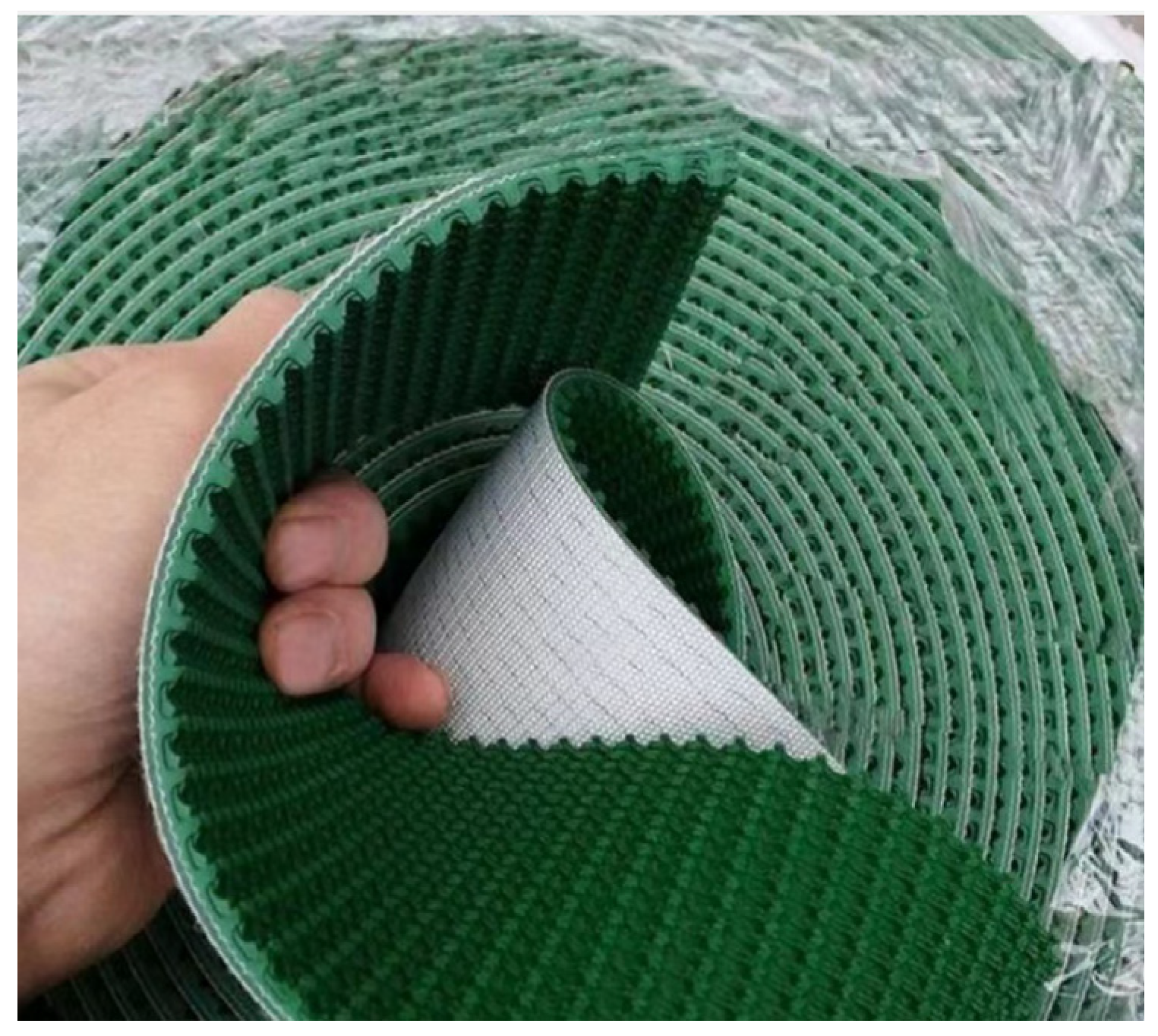
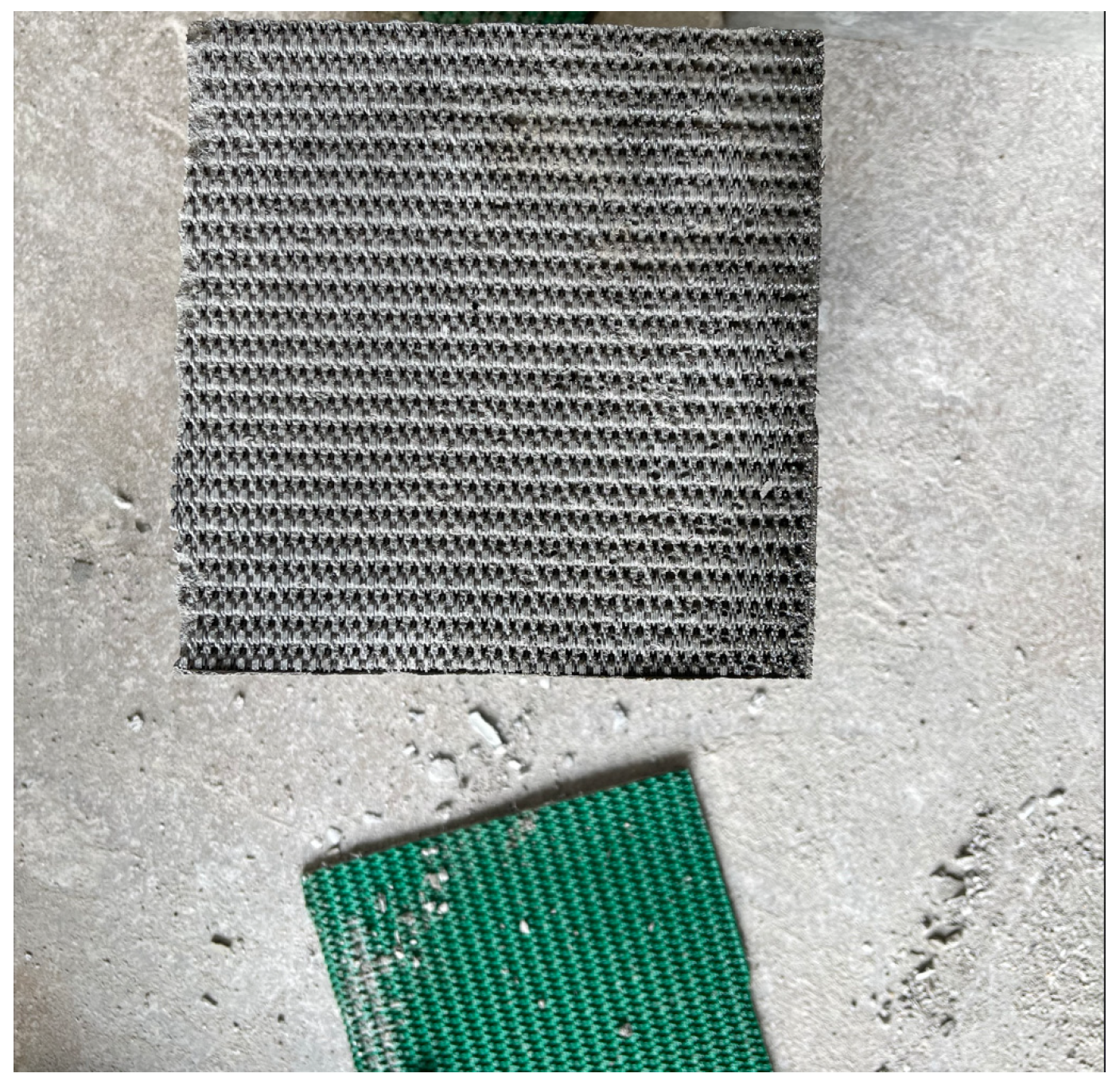
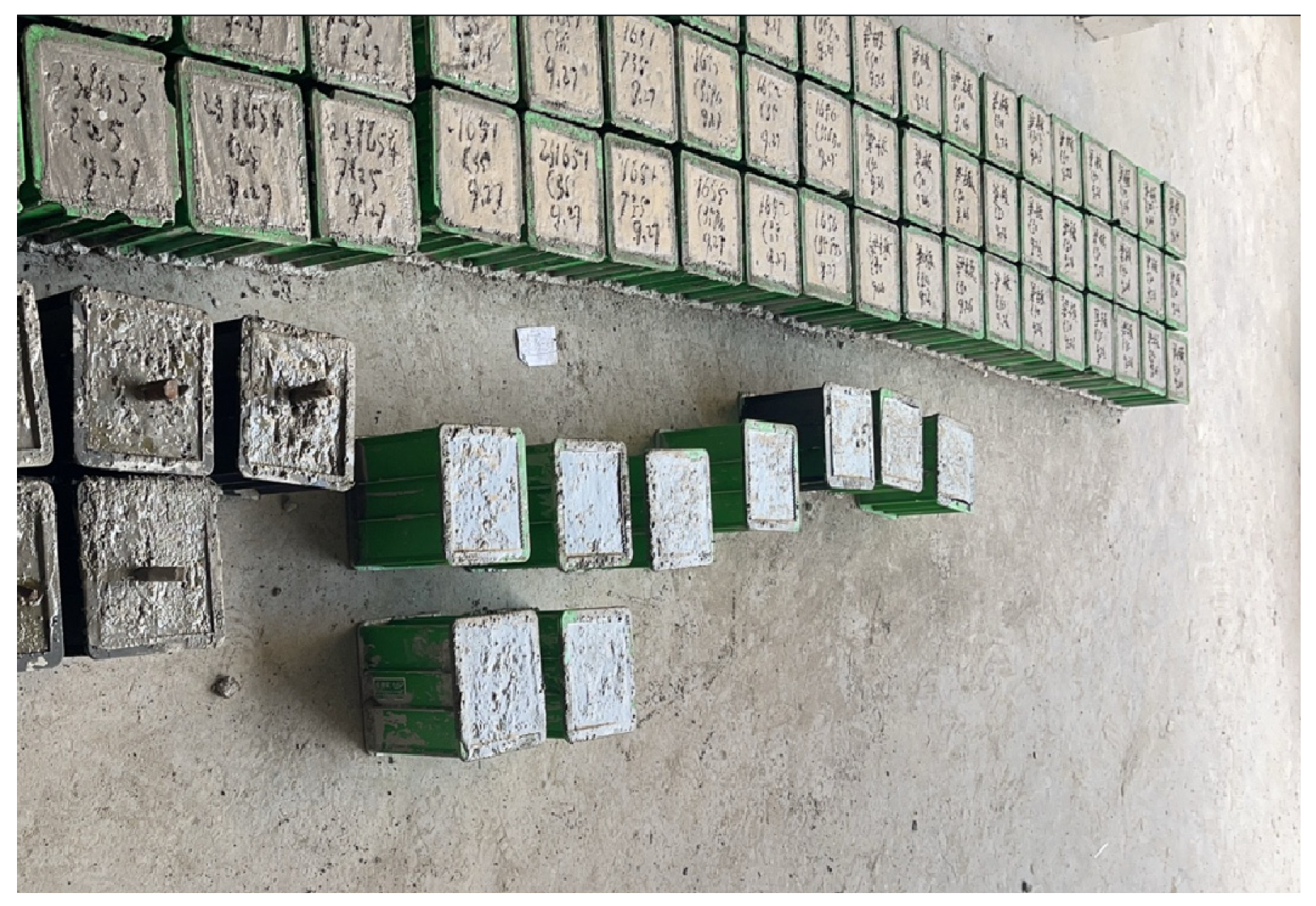
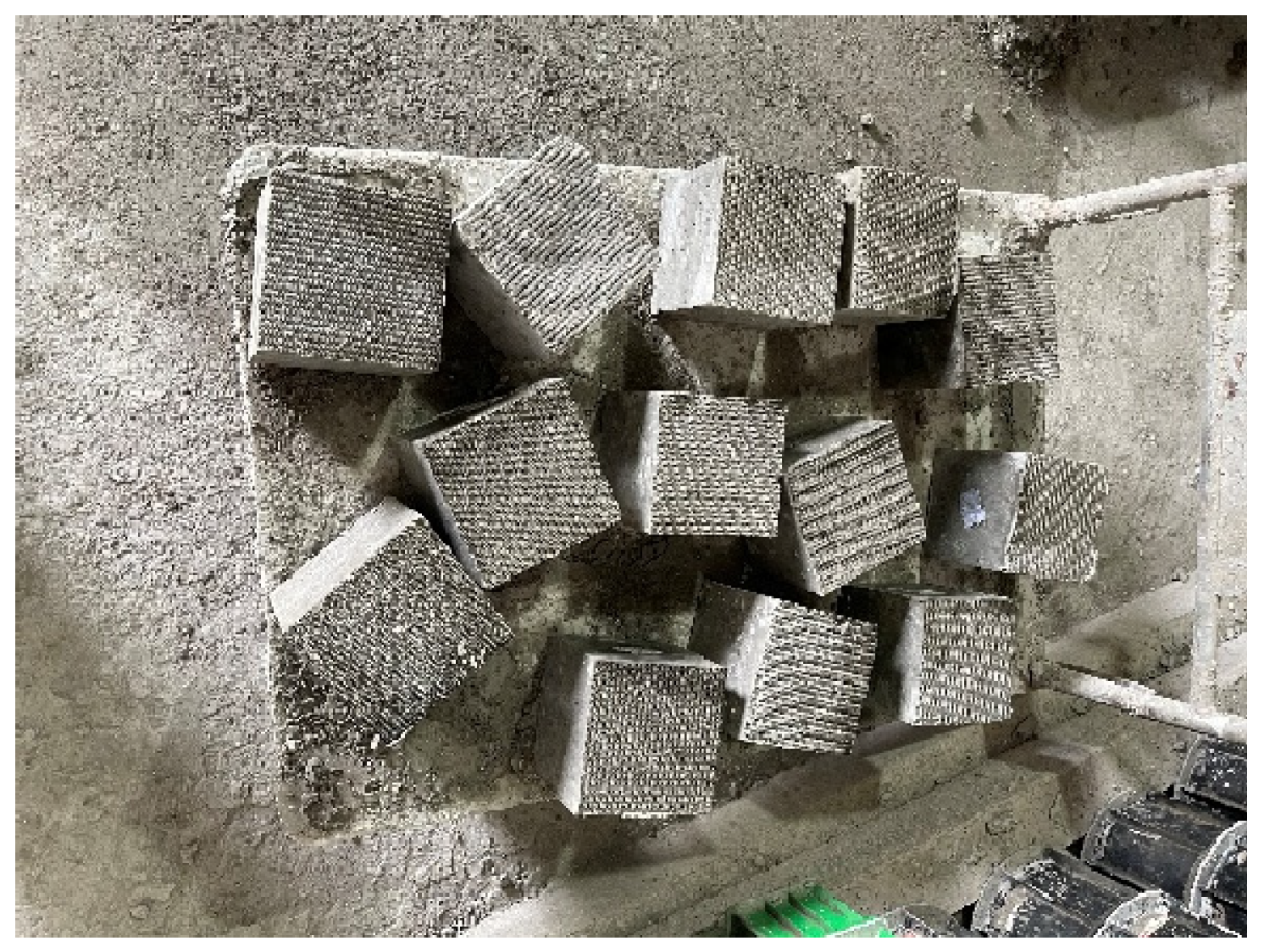

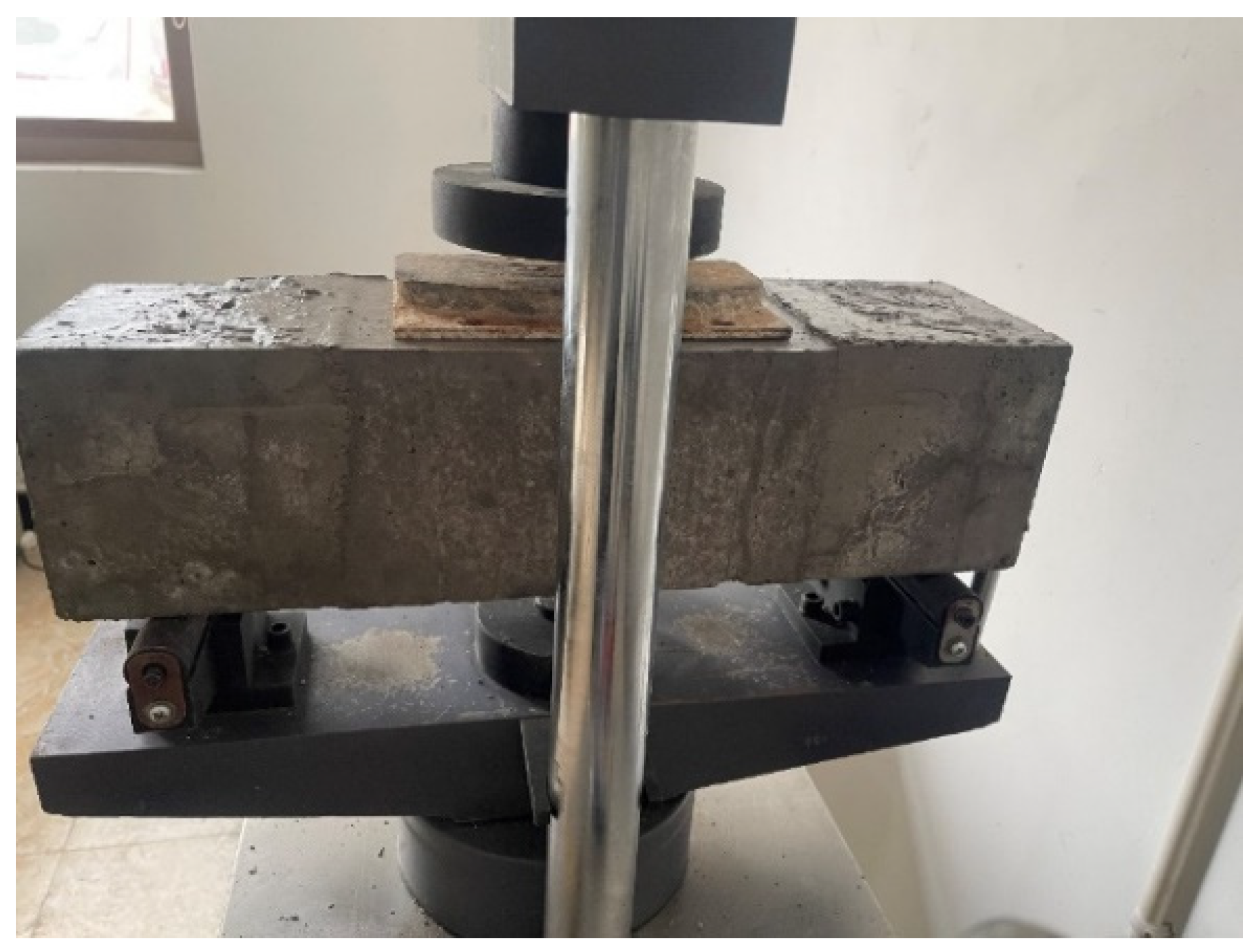
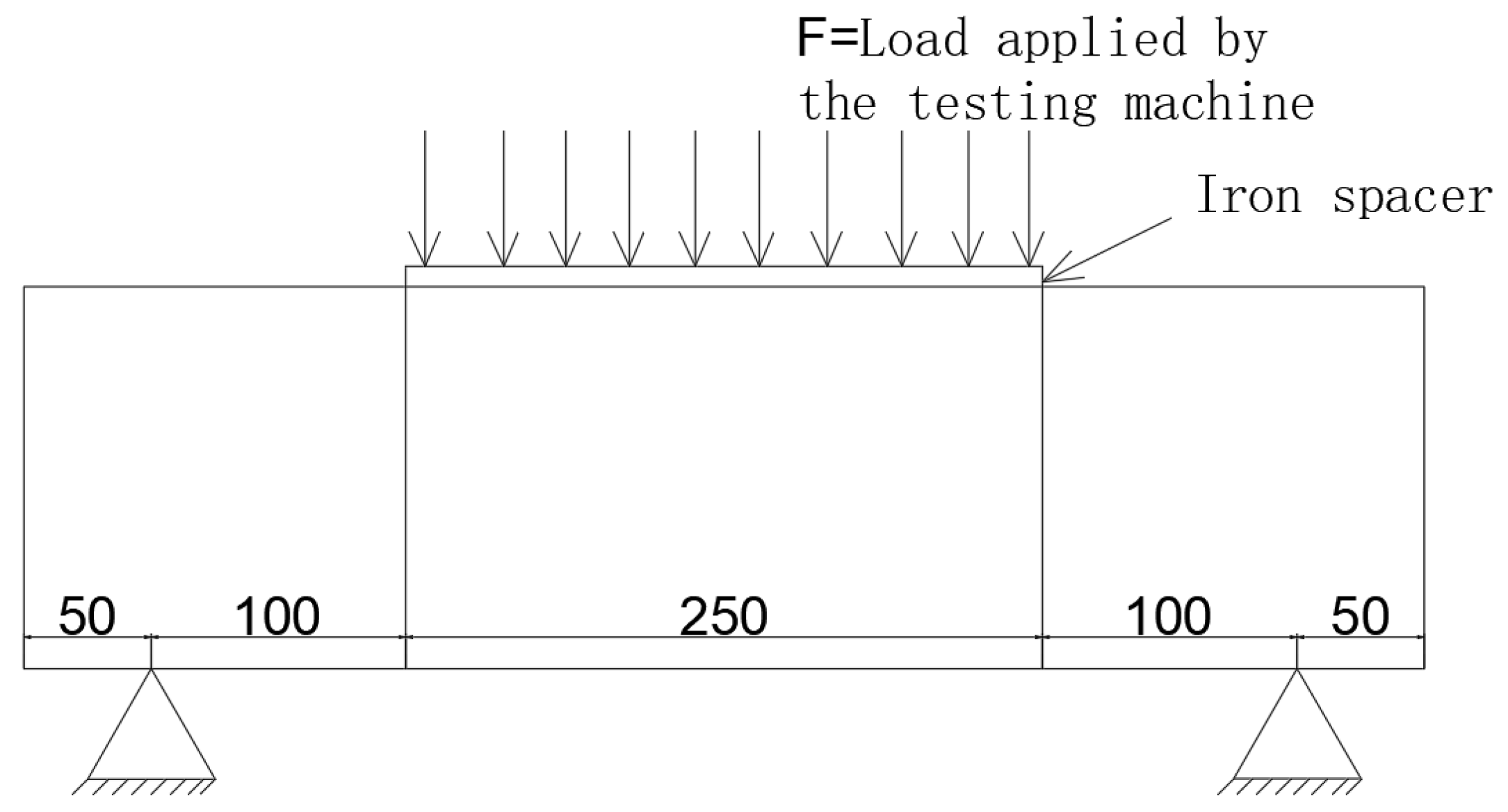
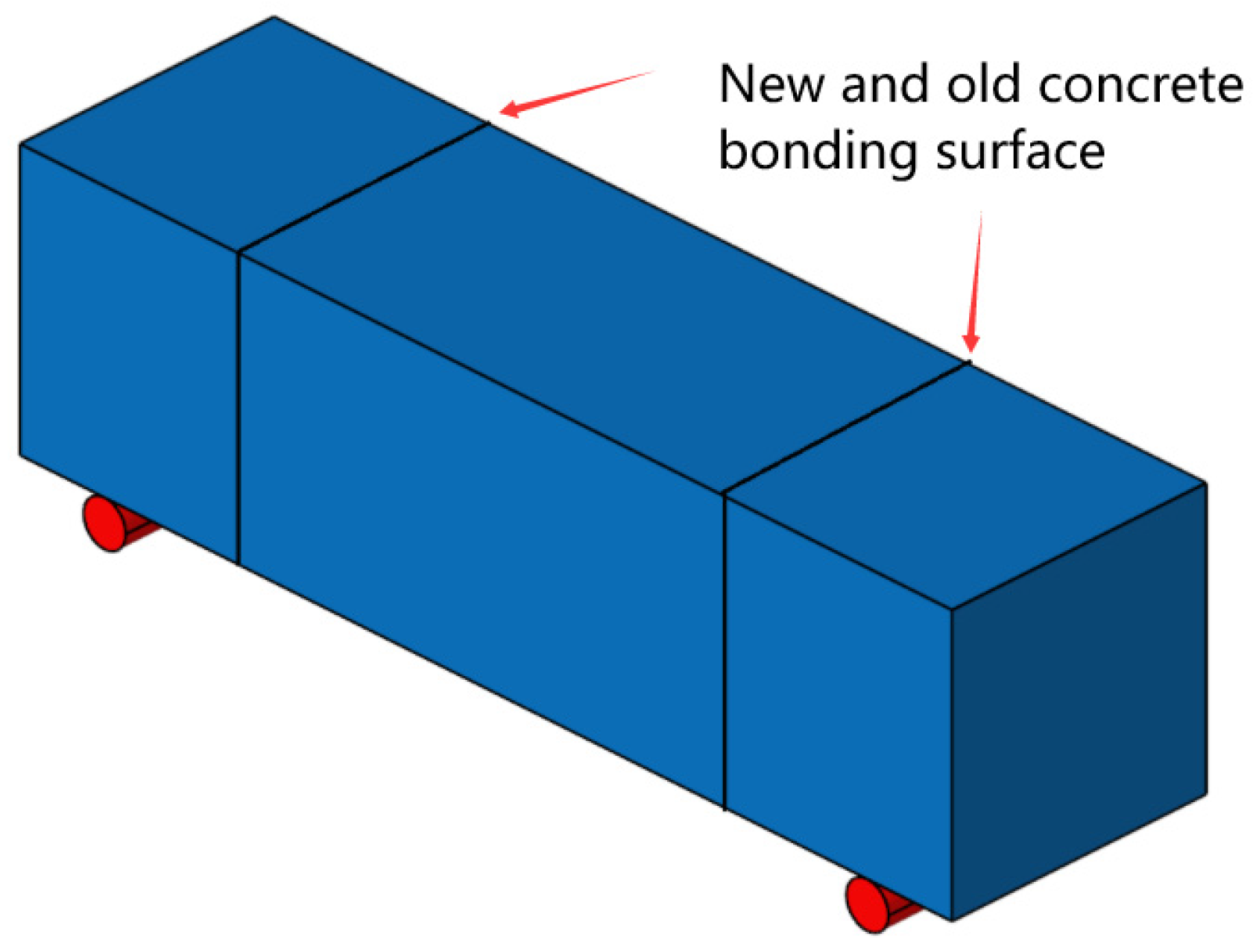
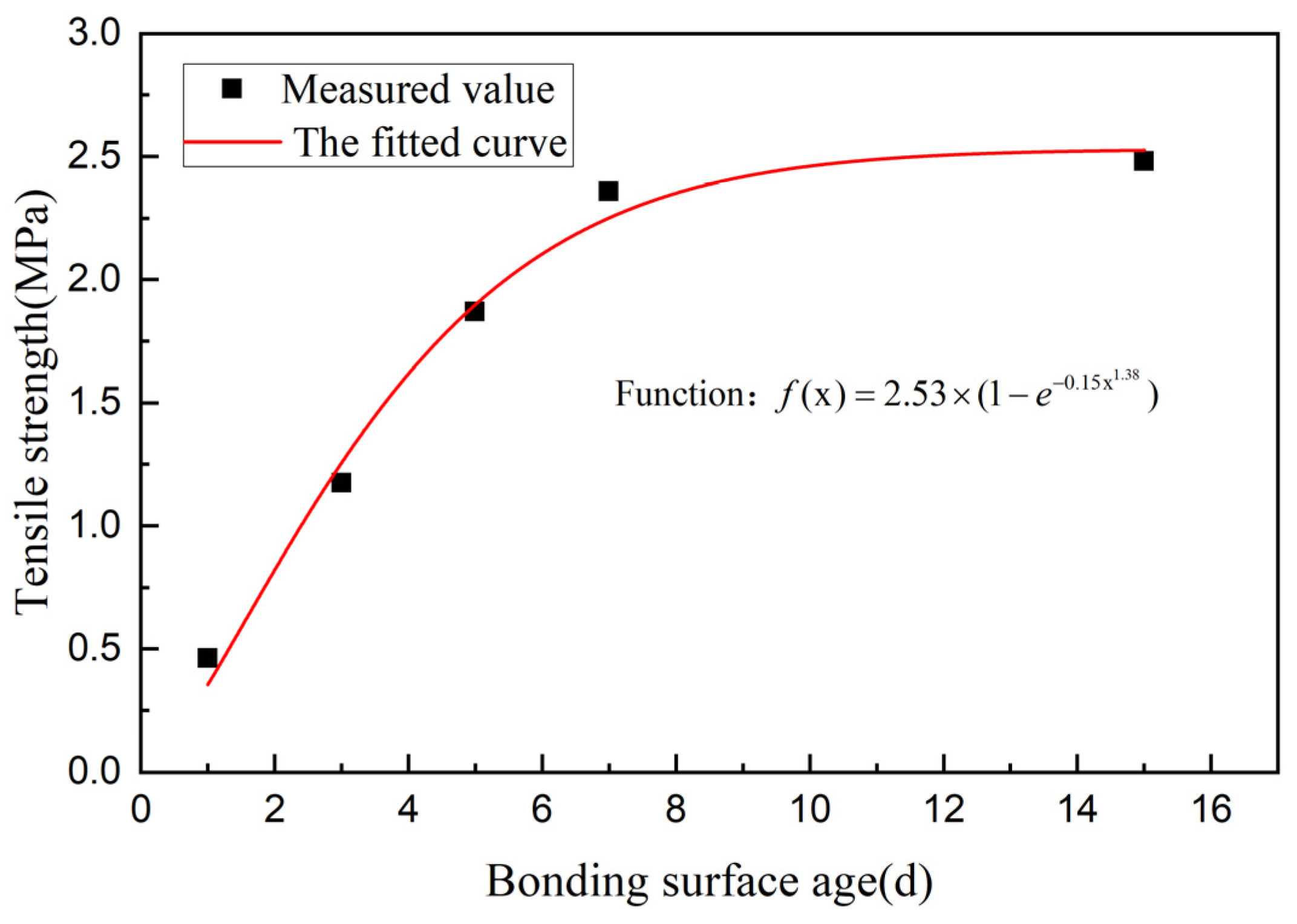


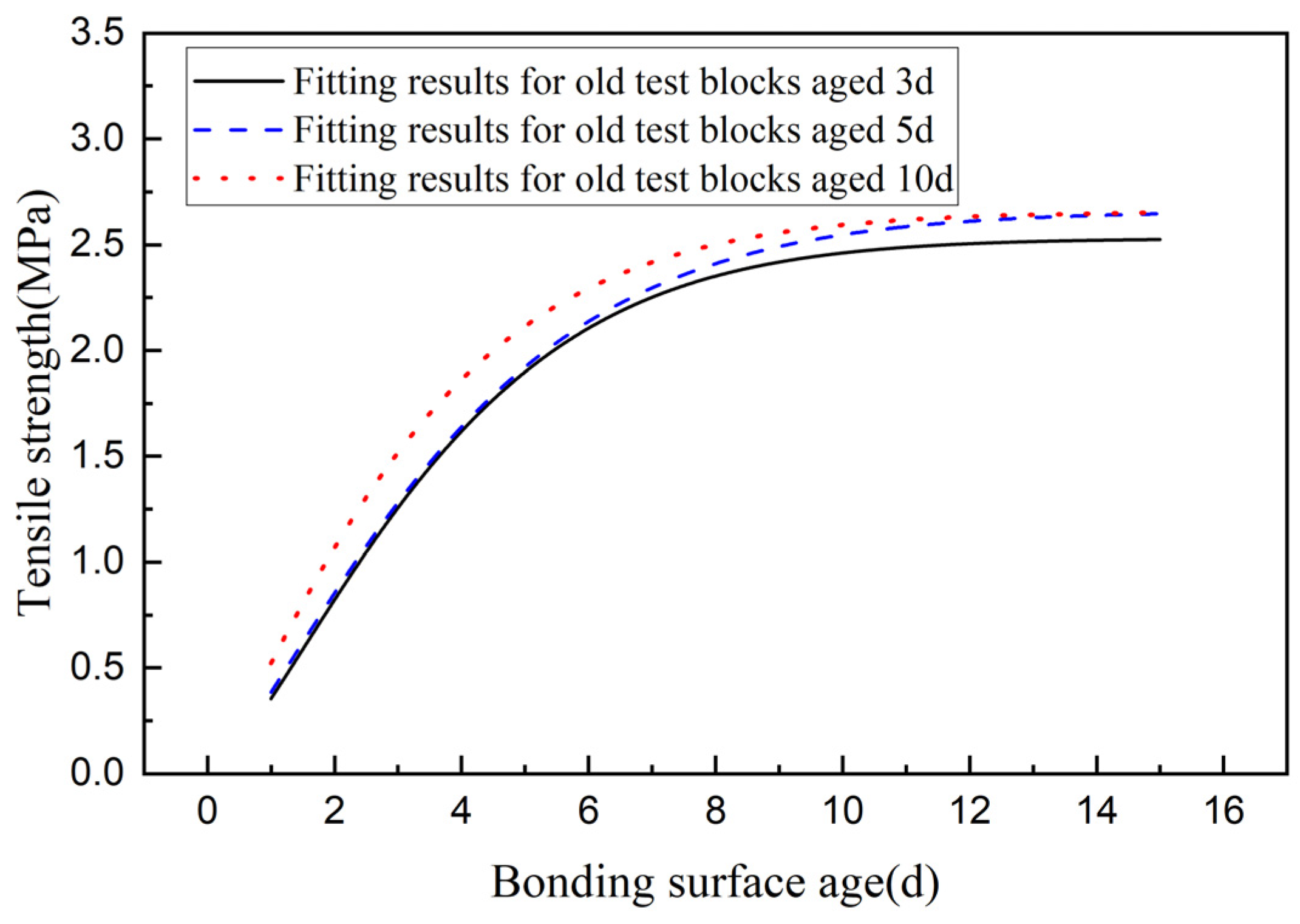
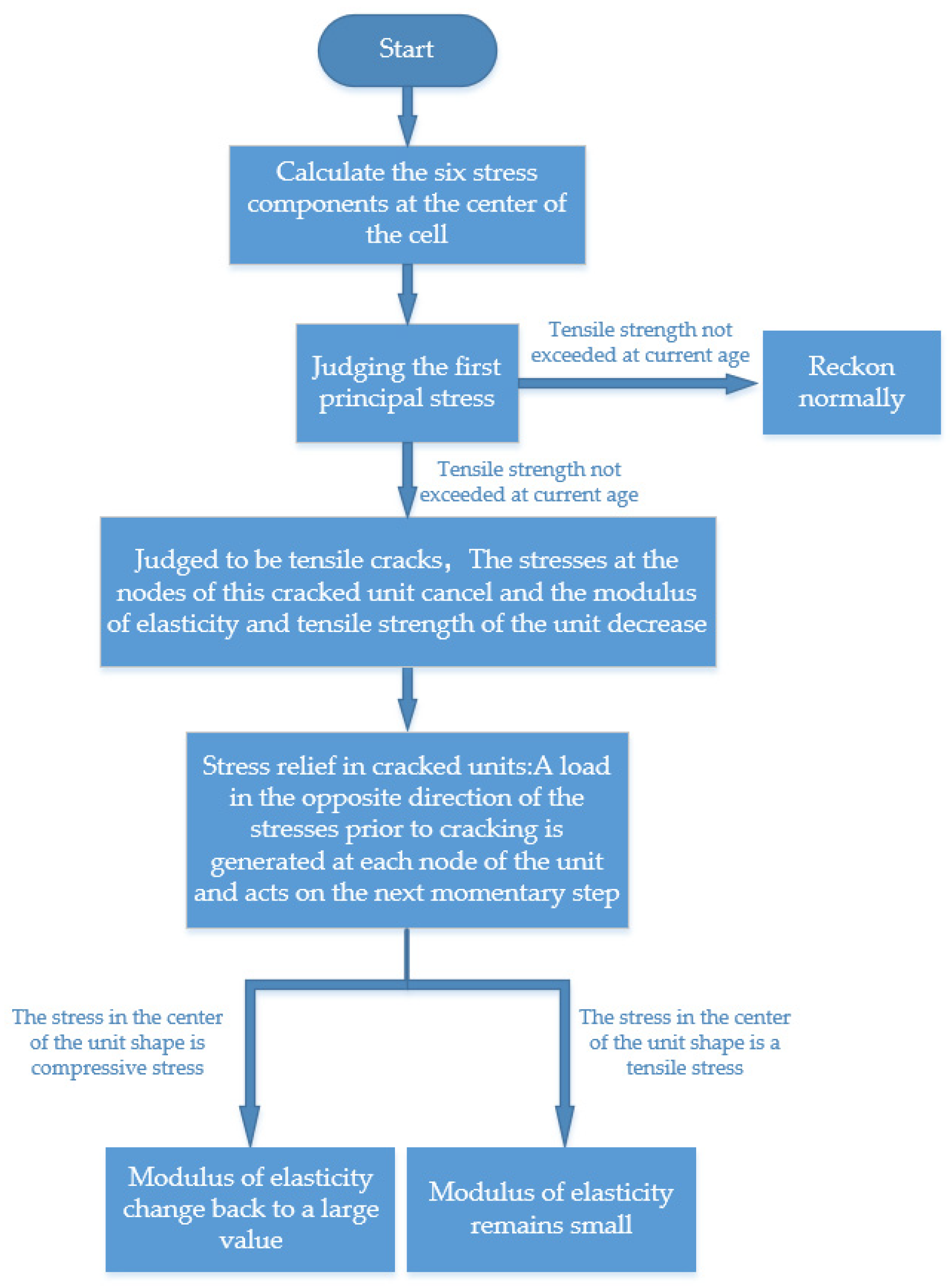


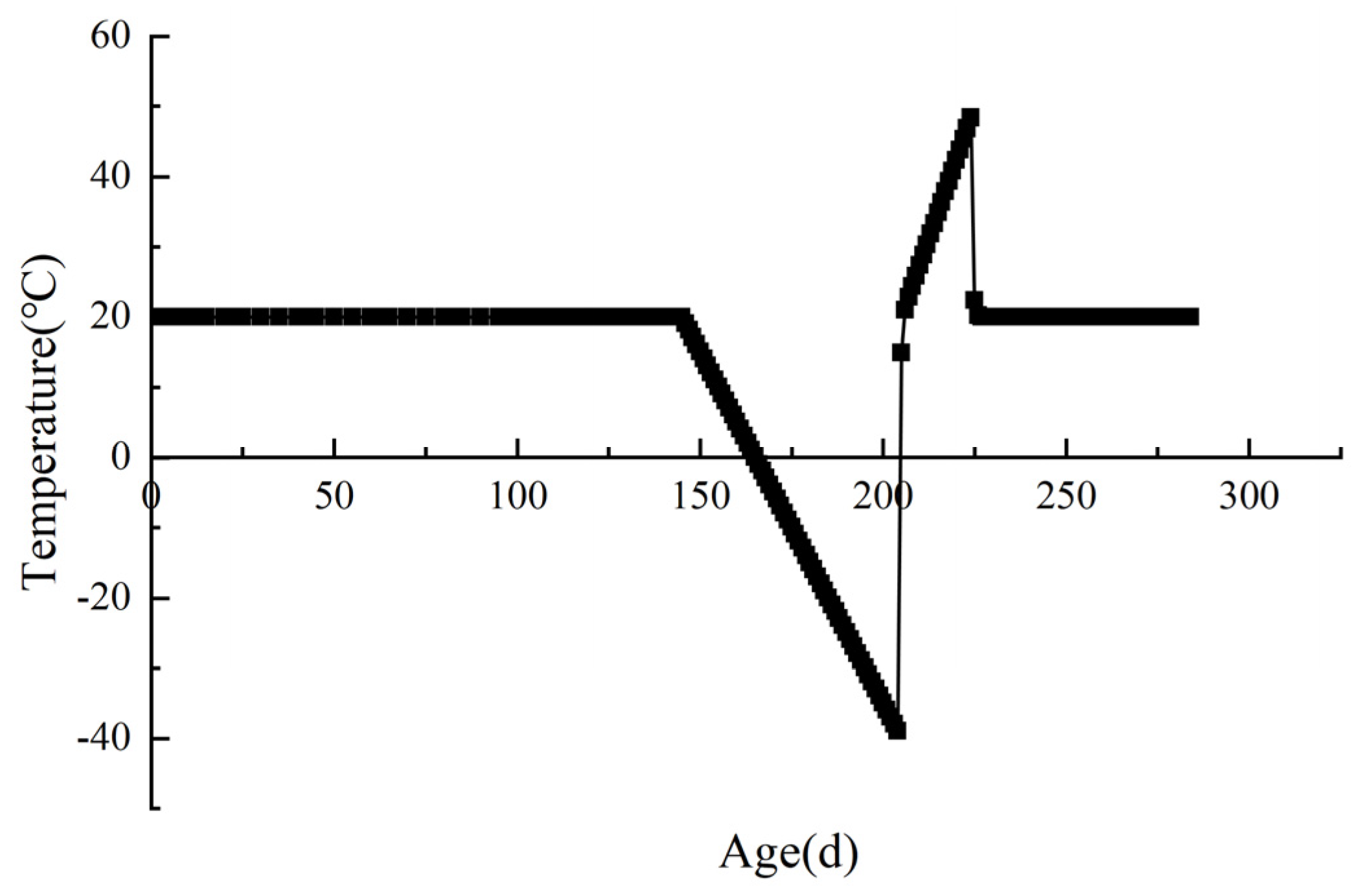

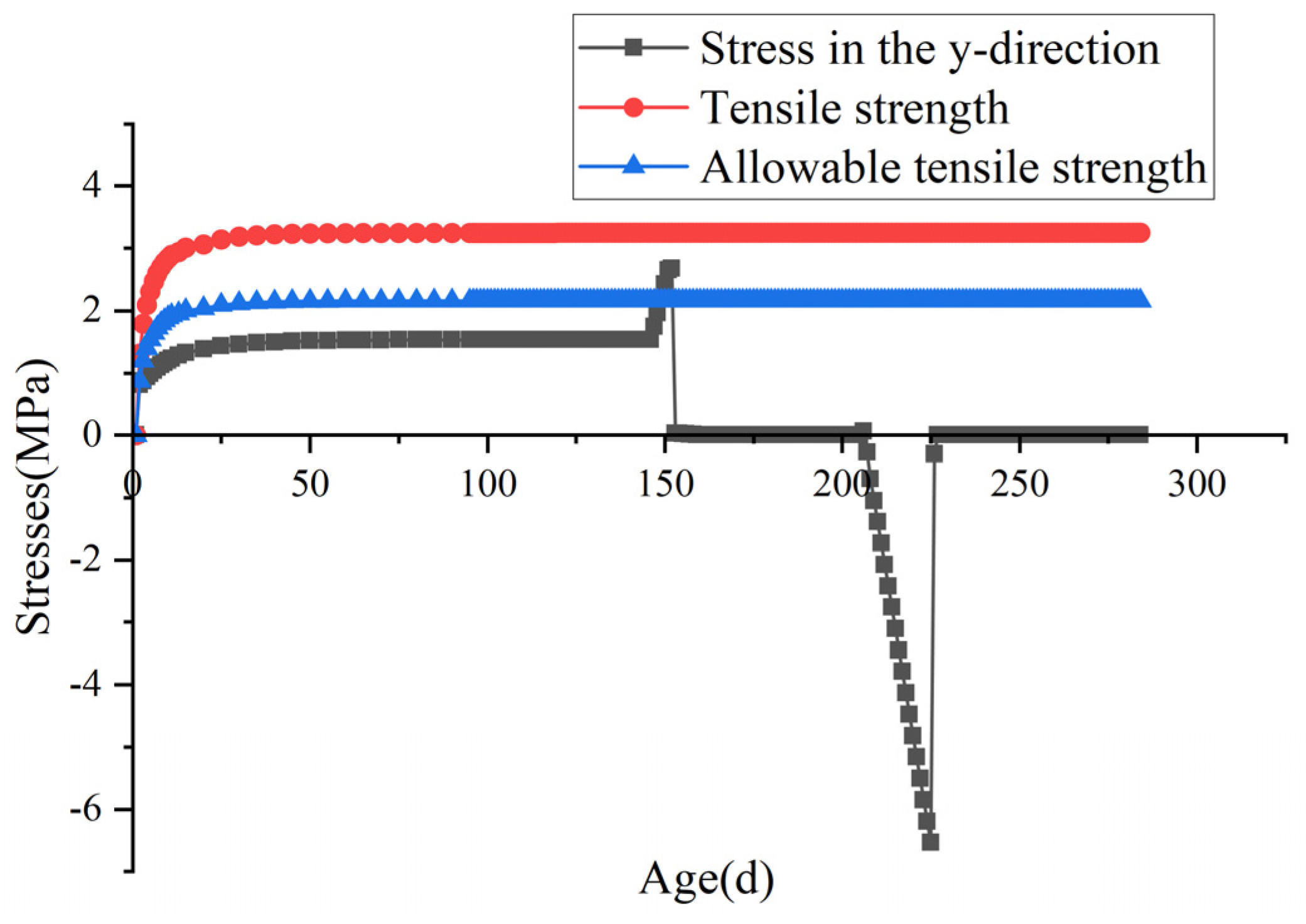
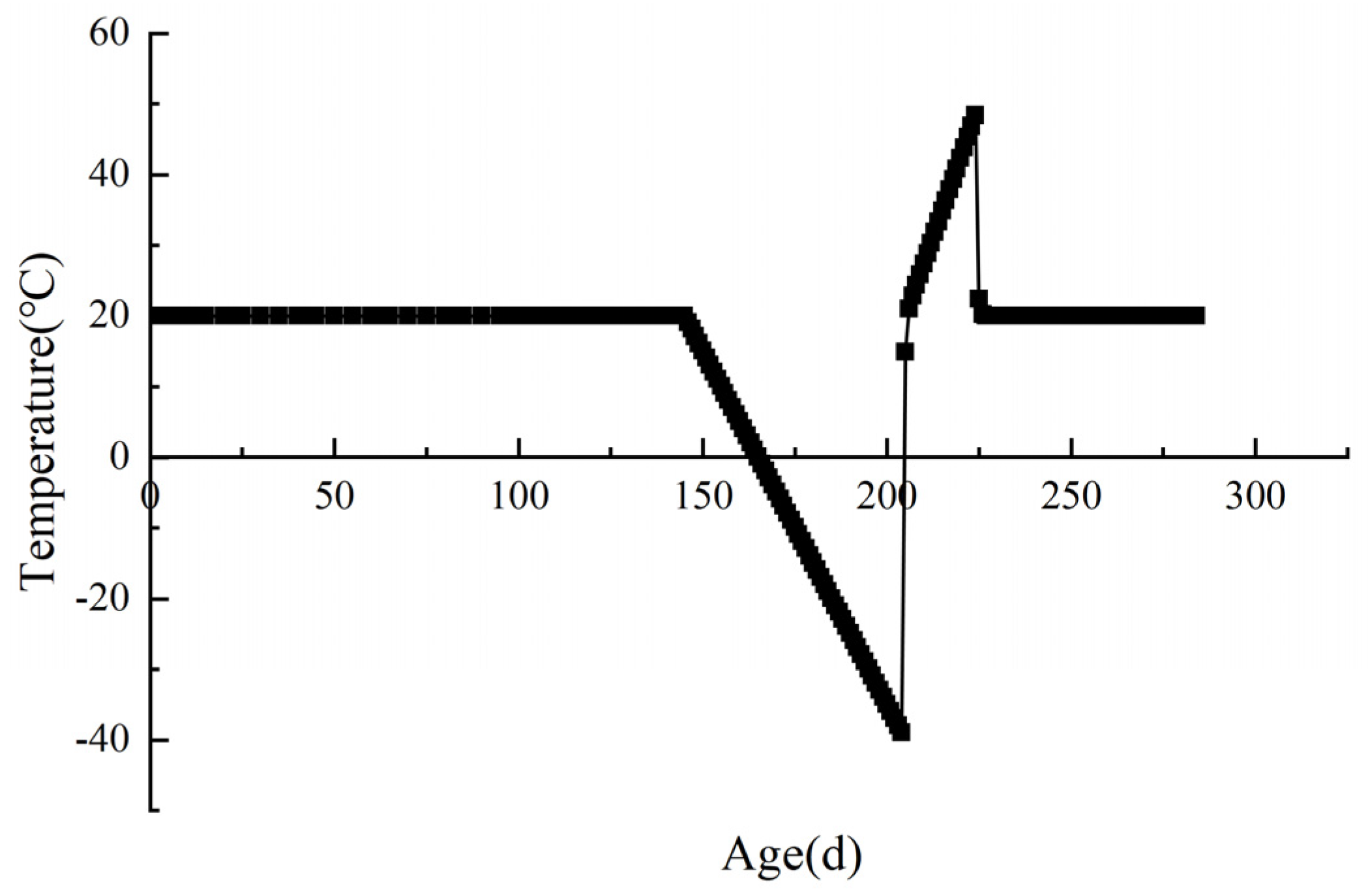
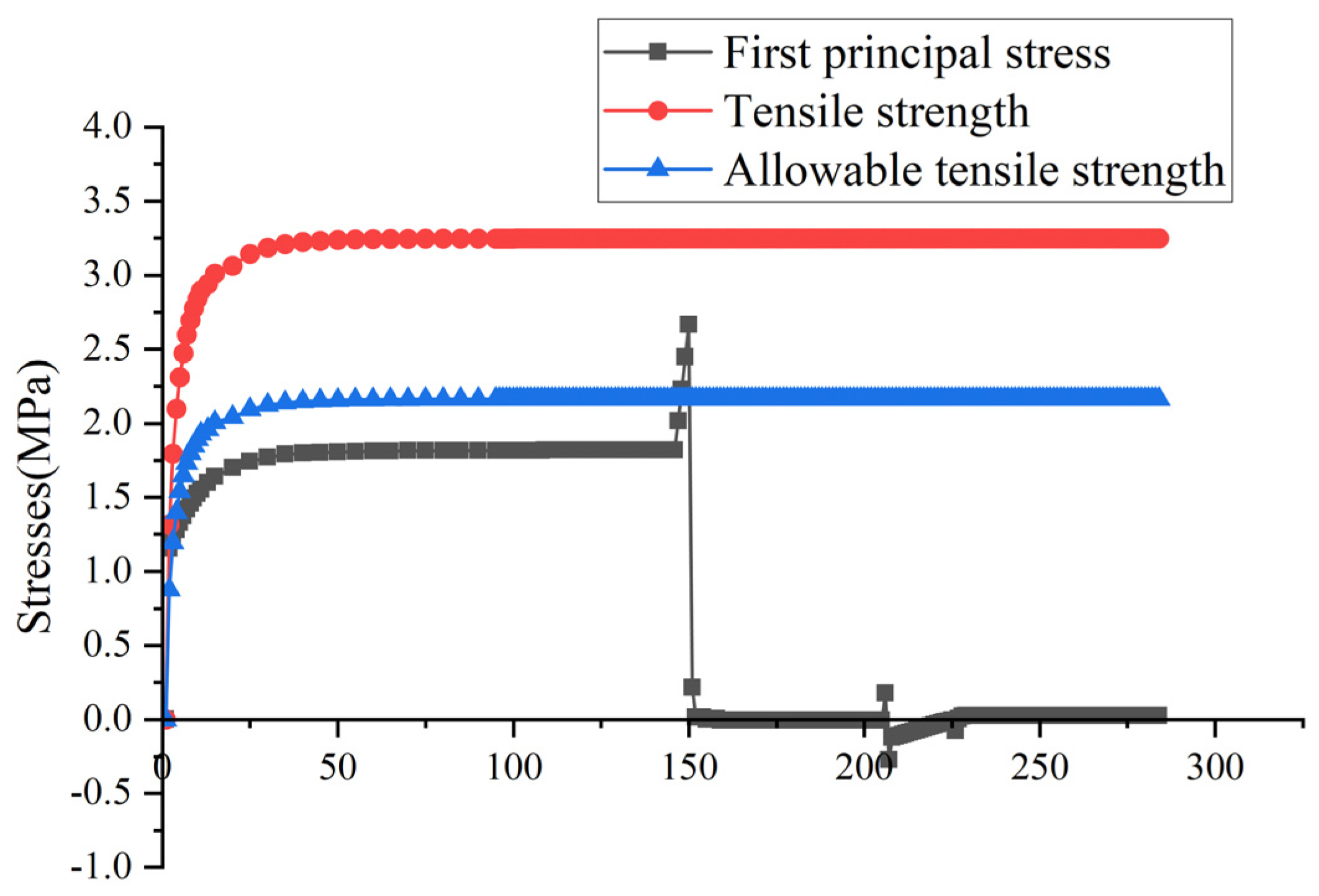
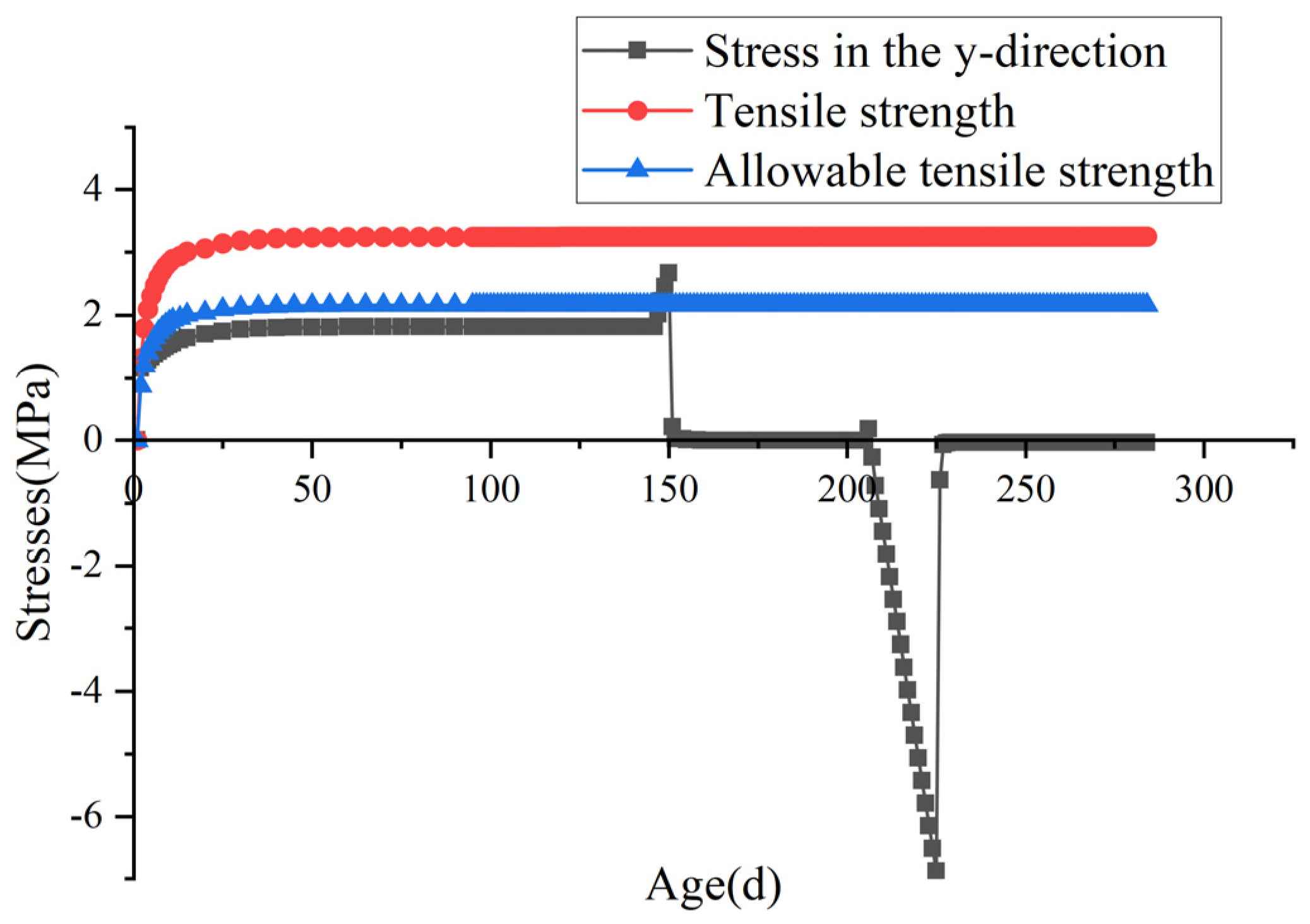
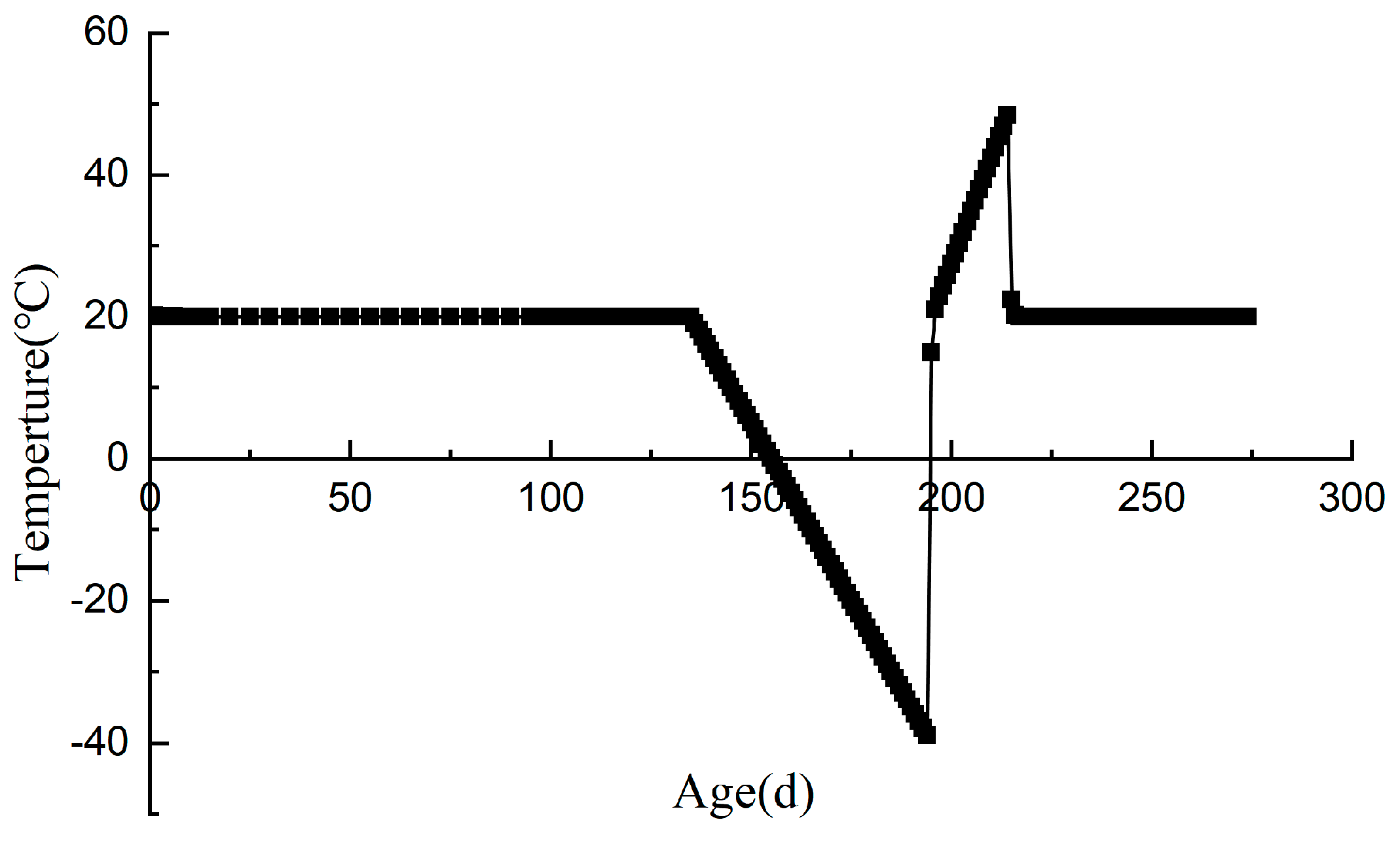
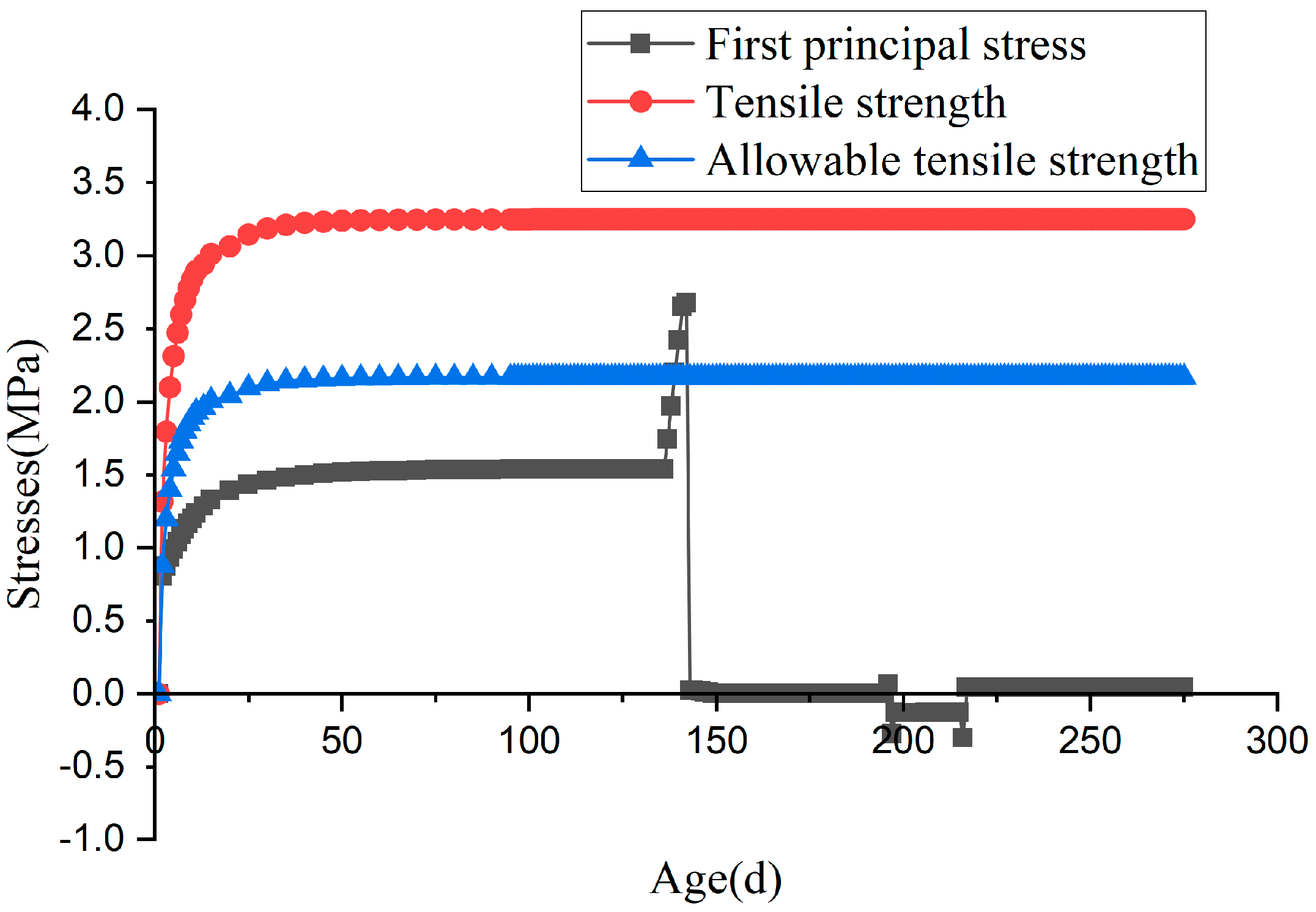
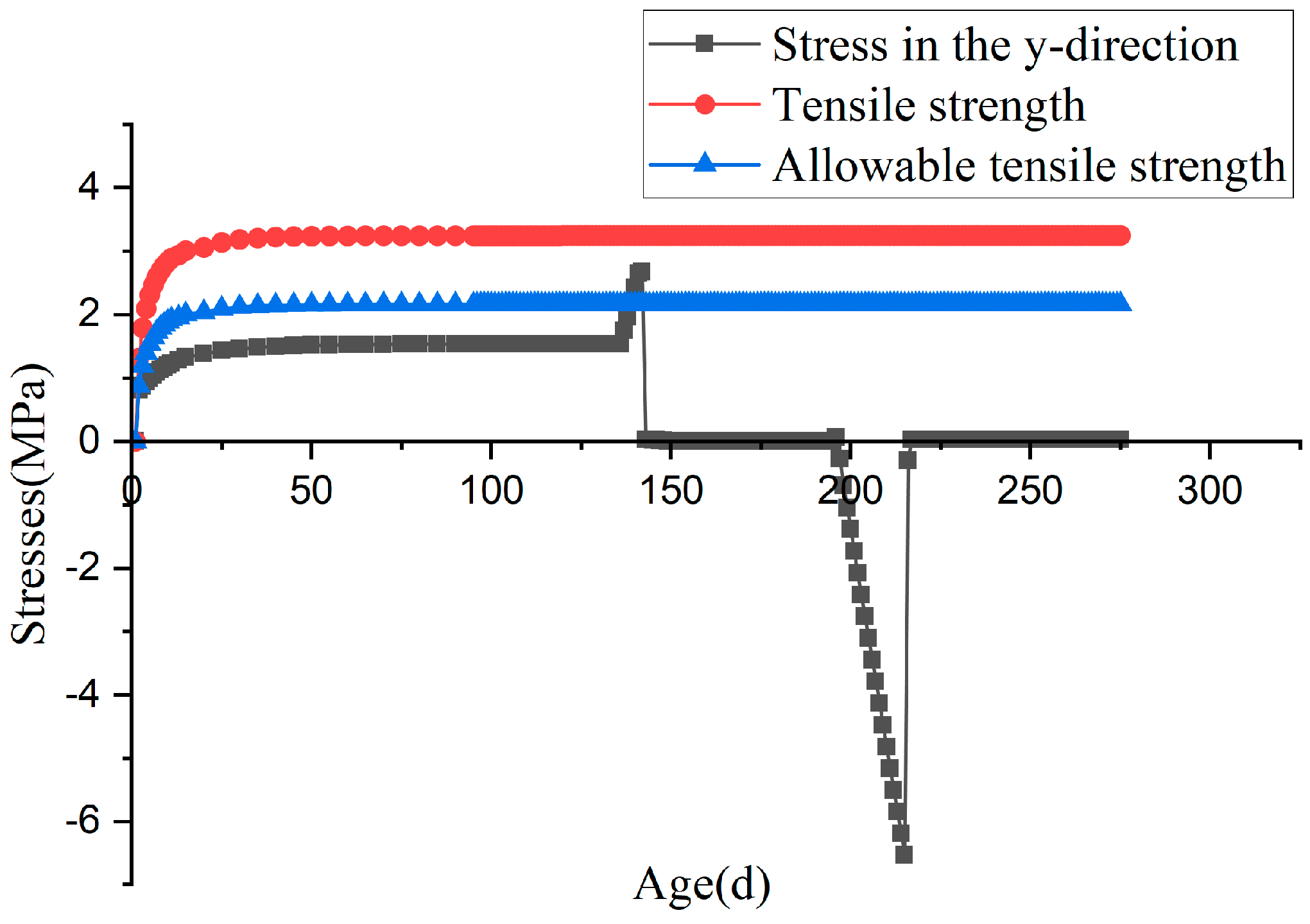
| Concrete Design Mix Ratio (kg/m3) | Cement | Mineral Powder | Fly Ash | Expansive Agent | Natural Sand | Manuf-actured Sand | Pebble Gravel | Large Gravel | Admixture | Water |
|---|---|---|---|---|---|---|---|---|---|---|
| 241 | 55 | 17 | 19 | 145 | 822 | 198 | 792 | 7 | 146 | |
| Apparent density (kg/m3) | Chloride ion content (%) | Total alkali content (kg/m3) | Slump (mm) | |||||||
| 2280 | 0.056 | 0.89 | 170 | |||||||
| Age of the Bonding Surface | 1d | 3d | 5d | 7d | 15d |
|---|---|---|---|---|---|
| loading (kN) | 5.20 | 13.2 | 21.03 | 26.52 | 27.9 |
| Age of the Bonding Surface | 1d | 3d | 5d | 7d | 15d |
|---|---|---|---|---|---|
| loading (kN) | 5.23 | 13.62 | 21.53 | 26.54 | 29.48 |
| Age of the Bonding Surface | 1d | 3d | 5d | 7d | 15d |
|---|---|---|---|---|---|
| loading (kN) | 5.63 | 17.34 | 23.82 | 26.90 | 29.98 |
| Thermal Conductivity Λ (kj/(m·h·°C)) | Specific Heat C (kj/(kg·°C)) | Thermal Diffusivity a (m2/h) | Coefficient of Linear Expansion A (1/°C) | Poisson’s Ratio μ | Densities ρ (kg/m3) | Final Modulus of Elasticity E0 (GPa) |
|---|---|---|---|---|---|---|
| 11.332 | 0.9699 | 0.0047 | 0.85 × 10−5 | 0.167 | 2430 | 30.1 |
| Feature Point Number | Coordinates of the X-Axis (m) | Coordinates of the Y-Axis (m) | Coordinates of the Z-Axis (m) |
|---|---|---|---|
| Feature point 1 | 0.05 | −3.25 | 0.05 |
| Feature point 2 | 0.05 | −2.50 | 0.05 |
| Feature point 3 | 0.05 | −1.75 | 0.05 |
Disclaimer/Publisher’s Note: The statements, opinions and data contained in all publications are solely those of the individual author(s) and contributor(s) and not of MDPI and/or the editor(s). MDPI and/or the editor(s) disclaim responsibility for any injury to people or property resulting from any ideas, methods, instructions or products referred to in the content. |
© 2024 by the authors. Licensee MDPI, Basel, Switzerland. This article is an open access article distributed under the terms and conditions of the Creative Commons Attribution (CC BY) license (https://creativecommons.org/licenses/by/4.0/).
Share and Cite
Shao, J.; Yuan, M.; Chen, Y.; Weng, M.; Wang, F.; Qiang, S. Experiment on the Tensile Strength of Concrete Joint Surface at Early Ages. Appl. Sci. 2024, 14, 6968. https://doi.org/10.3390/app14166968
Shao J, Yuan M, Chen Y, Weng M, Wang F, Qiang S. Experiment on the Tensile Strength of Concrete Joint Surface at Early Ages. Applied Sciences. 2024; 14(16):6968. https://doi.org/10.3390/app14166968
Chicago/Turabian StyleShao, Jingwei, Min Yuan, Yu Chen, Minghao Weng, Fusheng Wang, and Sheng Qiang. 2024. "Experiment on the Tensile Strength of Concrete Joint Surface at Early Ages" Applied Sciences 14, no. 16: 6968. https://doi.org/10.3390/app14166968
APA StyleShao, J., Yuan, M., Chen, Y., Weng, M., Wang, F., & Qiang, S. (2024). Experiment on the Tensile Strength of Concrete Joint Surface at Early Ages. Applied Sciences, 14(16), 6968. https://doi.org/10.3390/app14166968








